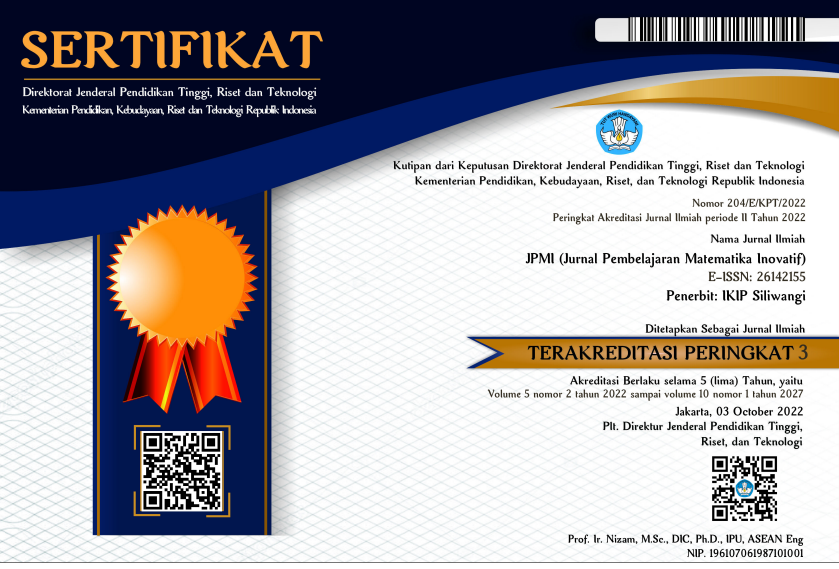ANALISIS KEMAMPUAN PEMECAHAN MASALAH MATEMATIS SISWA SMA PADA MATERI FUNGSI
DOI:
https://doi.org/10.22460/jpmi.v3i6.p%25pKeywords:
Problem solving ability, Function, Qualitatiiive descriptionAbstract
This study aims to describe students’ problem solving abilities in the function material. This research is a qualitative descriptive study. The subjects of this study were 15 students of class X students of Muhammadiyah 1 Cimahi High School. The method used to collect data is by using written worksheets with mathematical problem solving abilities at the function table. The results showed that the ability to solve mathematical problem solving in class X high school Muhammaiyah was already high, as seen from the presentation stating that students were able to identify known elements, implement strategies and develop mathematical models. Overall students mathematical problem solving abilities, especially in material function are in high qualifications.
References
Akbar, P., Hamid, A., Bernard, M., & Sugandi, A. I. (2017). Analisis Kemampuan Pemecahan Masalah Dan Disposisi Matematik Siswa Kelas Xi Sma Putra Juang Dalam Materi Peluang. Jurnal Cendekia : Jurnal Pendidikan Matematika, 2(1), 144–153. https://doi.org/10.31004/cendekia.v2i1.62
Alexander, A. (2011). The Skeleton in the Closet: Should Historians of Science Care about the History of Mathematics? Isis, 102(3), 475-480.
Atkinson, J. (2017). Qualitative Methods. In Journey into Social Activism: Qualitative Approaches (pp. 65-98). New York: Fordham University Press.
Bernard, M., Nurmala, N., Mariam, S., & Rustyani, N. (2018). Analisis Kemampuan Pemecahan Masalah Matematis Siswa SMP Kelas IX pada Materi Bangun Datar. SJME (Supremum Journal of Mathematics Education), 2(2), 77–83.
Brahier, D., Leinwand, S., & Huinker, D. (2014). Principles to Actions: Mathematics Programs as the Core for Student Learning. The Mathematics Teacher, 107(9), 656-658. doi:10.5951/mathteacher.107.9.0656.
De Witte, K., Titl, V., Holz, O., & Smet, M. (2019). Overview of education systems. In Financing Quality Education for All: The Funding Methods of Compulsory and Special Needs Education (pp. 25-40). Leuven (Belgium): Leuven University Press.
Engelhardt, N. (2018). Modern by numbers: Modern mathematics as a model for literary modernism. In G. P. Bud R., Being Modern: The Cultural Impact of Science in the Early Twentieth Century (pp. 169-187). London: UCL Press.
Fallis, A. . (2013). Turbulence Modelling for CFD. Journal of Chemical Information and Modeling. https://doi.org/10.1017/CBO9781107415324.004
Fitria,N., Hidayani,N.,Hendriana,H., R. A. (2018). Analisis Kemampuan Pemecahan Masalah Matematik Siswa SMP dengan Materi Segitiga dan Segiempat. Edumatica, 08(April), 49–57. Retrieved from https://online-journal.unja.ac.id/index.php/edumatica
Friedland, E., McMillen, S., & Del Prado Hill, P. (2011). Collaborating to Cross the Mathematics-Literacy Divide: An Annotated Bibliography of Literacy Strategies for Mathematics Classrooms. Journal of Adolescent & Adult Literacy, 55(1), 57-66.
George, M. (2014). Mathematics Teaching as a Narrative Art. The Mathematics Teacher, 108(4), 266-271.
Gray, J. (2011). History of Mathematics and History of Science Reunited? Isis, 102(3), 511-517.
Hadlock, C. R. (2013). Underground Mathematics. The College Mathematics Journal, 44(5), 364-375.
Hamilton, L., Kaufman, J., Stecher, B., Naftel, S., Robbins, M., Thompson, L., & . . . Opfer, V. (2016). What Supports Do Teachers Need to Help Students Meet Common Core State Standards for Mathematics?: Findings from the American Teacher and American School Leader Panels. In What Supports Do Teachers Need to Help Students Meet Common Core State Standards for Mathematics?: Findings from the American Teacher and American School Leader Panels (pp. 1-8). RAND Corporation.
Hendriana, H., Rohaeti, E. E., & Sumarmo, U. (2017). Hard Skills dan Soft Skills Matematik siswa. Bandung: Refika Aditama.
Huang, T.-H., Liu, Y.-C., & Chang, H.-C. (2012). Learning Achievement in Solving Word-Based Mathematical Questions through a Computer-Assisted Learning System. Journal of Educational Technology & Society, 15(1), 248-259.
Lalingkar, A., Chandrshekar, R., & Ramani, S. (2015). MONTO: A Machine-Readable Ontology for Teaching Word Problems in Mathematics. Journal of Educational Technology & Society, 18(3), 197-213.
Lane, A. (2016). Emancipation through Open Education: Rhetoric or Reality? In Blessinger P. & Bliss T. (Eds.). In Open Education: International Perspectives in Higher Education (pp. 31-50). Cambridge, UK: Open Book.
Opfer, V., Kaufman, J., & & Thompson, L. (2016). Teachers' Perceptions and Practices Related to Mathematics State Standards. In Implementation of K-12 State Standards for Mathematics and English Language Arts and Literacy: Findings from the American Teacher Pane (pp. 73-94). Santa Monica, Calif: RAND Corporation.
Ossiannilsson, E., Altinay, Z., & Altinay, F. (2016). Transformation of Teaching and Learning in Higher Education towards Open Learning Arenas: A Question of Quality. In B. P. (Eds.), Open Education: International Perspectives in Higher Education (pp. 159-178). Cambridge, UK: Open Book.
Richards, J. (2011). "This Compendious Language": Mathematics in the World of Augustus De Morgan. Isis, 102(3), 506-510. doi:10.1086/661624.
Rosalina, D. (2016). Penerapan Pembelajaran Inkuiri Terbimbing Terhadap Kemampuan Pemecahan Masalah dan Koneksi Matematik Siswa SMP ditinjau dari Tingkat Kecemasan Matematika. STKIP Siliwangi Bandung.
Smith, K. (2016). Leibniz on Order Harmony, and the Notion of Substance: Mathematizing the Sciences of Metaphysics and Physics. In H. B. GORHAM G., The Language of Nature: Reassessing the Mathematization of Natural Philosophy in the Seventeenth Century (pp. 229-249). Minneapolis; London: University of Minnesota Press.
Sun-Lin, H., & Chiou, G. (2019). Effects of Gamified Comparison on Sixth Graders' Algebra Word Problem Solving and Learning Attitude. Journal of Educational Technology & Society, 22(1), 120-130.
Thompson, D., & Rubenstein, R. (2014). Literacy in Language and Mathematics: More in Common Than You Think. Journal of Adolescent & Adult Literacy, 58(2), 105-108.
Veugelers, W., & Groot, I. (2019). Theory and Practice of Citizenship Education. In V. W. (Ed.), Education for Democratic Intercultural Citizenship (pp. 14-41). Leiden; Boston: Brill doi:10.1163/j.ctvrxk389.6.
Wulandari, A., Nurcahya, A., & kadarisma, G. (2018). Hubungan Antara Self Confidence Dengan Kemampuan Pemecahan Masalah Matematis Siswa SMA. 1(April), 799–806. https://doi.org/10.22437/edumatica.v8i01.4623
Zengin, Y., & Tatar, E. (2017). Integrating Dynamic Mathematics Software into Cooperative Learning Environments in Mathematics. ournal of Educational Technology & Society, 20(2), 74-88.
Zulkifli. (2013). Education. In The Struggle of the Shi'is in Indonesia (pp. 141-162). ANU Press.

















